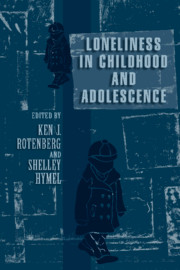Book contents
- Frontmatter
- Contents
- Contributors
- PART I INTRODUCTION
- PART II THEORETICAL AND ASSESSMENT ISSUES
- PART III LONELINESS IN CHILDHOOD
- PART IV LONELINESS IN ADOLESCENCE
- 11 Adolescent Loneliness, Self-Reflection, and Identity: From Individual Differences to Developmental Processes
- 12 The Uses of Loneliness in Adolescence
- 13 Social Self-Discrepancy Theory and Loneliness During Childhood and Adolescence
- 14 Self, Other, and Loneliness From A Developmental Perspective
- 15 Adolescent Loneliness and Adjustment: A Focus on Gender Differences
- PART V PROSPECTIVE
- References
- Author Index
- Subject Index
- Plate section
11 - Adolescent Loneliness, Self-Reflection, and Identity: From Individual Differences to Developmental Processes
Published online by Cambridge University Press: 13 October 2009
- Frontmatter
- Contents
- Contributors
- PART I INTRODUCTION
- PART II THEORETICAL AND ASSESSMENT ISSUES
- PART III LONELINESS IN CHILDHOOD
- PART IV LONELINESS IN ADOLESCENCE
- 11 Adolescent Loneliness, Self-Reflection, and Identity: From Individual Differences to Developmental Processes
- 12 The Uses of Loneliness in Adolescence
- 13 Social Self-Discrepancy Theory and Loneliness During Childhood and Adolescence
- 14 Self, Other, and Loneliness From A Developmental Perspective
- 15 Adolescent Loneliness and Adjustment: A Focus on Gender Differences
- PART V PROSPECTIVE
- References
- Author Index
- Subject Index
- Plate section
Summary
The present chapter focuses on adolescence and illustrates some of the developments that have taken place in research on loneliness during the past few years. Historically, much of the previous research in this area takes the view that loneliness is a sad predicament that is primarily experienced by selected groups of children, such as rejected children (see Asher et al., 1990, for a review) or the learning disabled (Margalit, 1994). Poor relationships with peers are thought to be at the heart of the problem in both cases. The present chapter joins with other chapters in this volume and reflects a growing awareness that loneliness is experienced to a certain degree by everyone (e.g., Hymel, Tarulli, Hayden Thomson, & Terrell-Deutsch, this volume) and that these feelings of relational dissatisfaction are intimately related to various positive developmental changes that take place during adolescence in particular (Larson, this volume).
In line with recent developments in the domain, the present chapter also makes a sharp distinction between loneliness on the one hand and aloneness or solitude (i.e., the state of being alone) on the other. Several authors (Cassidy & Asher, 1992; Hymel et al., this volume; Youngblade, Berlin, & Belsky, this volume) have demonstrated that children and adolescents can and do distinguish between these two constructs. On the basis of these findings, an awareness that being alone does not necessarily imply loneliness is currently viewed as a necessary component of a true understanding of what loneliness is. In the present chapter, however, we take this line of reasoning one step further and suggest that individuals' attitude toward being alone be measured in addition to their feelings of loneliness.
Information
- Type
- Chapter
- Information
- Loneliness in Childhood and Adolescence , pp. 225 - 243Publisher: Cambridge University PressPrint publication year: 1999
Accessibility standard: Unknown
- 56
- Cited by
